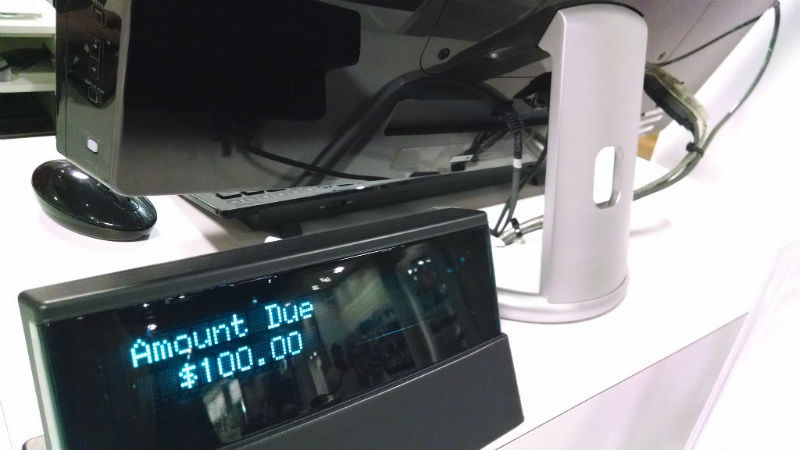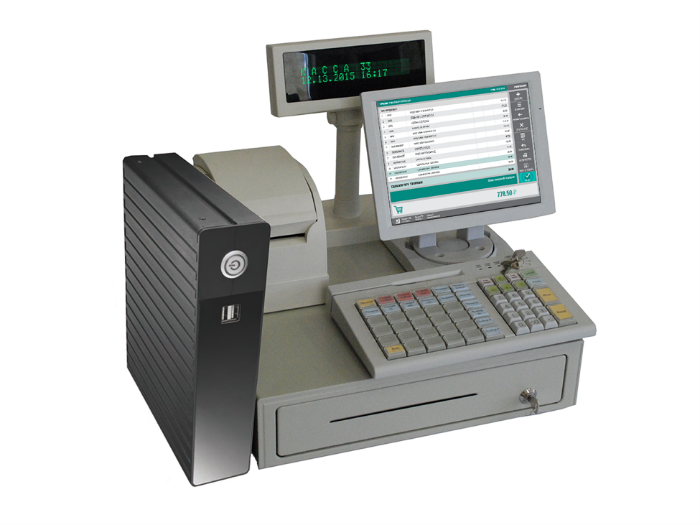Retail technologies: how modern cash desks are arranged

Image: Aranami , Flickr
In our blog, we already talked about what interesting technologies and hardware are used in modern stores, and how the maintenance of such complex devices is organized. Today we will dwell on one of the most important elements of the retail infrastructure, and talk about the structure of POS cash registers.
')
Infrastructure classics
Cash register equipment is divided into two large classes of devices - modular dispersed and sensory cash registers. Let's talk about the pros and cons of each.
Touch Boxes
Sensory cash registers are used in industries where the speed of customer service, compactness of the workplace, its beauty and aesthetics are important - usually restaurants, shops selling clothes, shoes and jewelry.
One of the main advantages of sensory cash registers is their compactness: it is more convenient for store employees to use such cash registers. At the same time, every square room space costs money, therefore, it is more profitable for the owners of retail outlets to save space by placing there not infrastructure objects, but goods or some kind of advertising - therefore compactness of sensory cash registers is important.
For example, our devices have an IP65 protection class from moisture, dust and other harmful factors - this also plays an important role in their selection for installation, for example, in restaurants. Since the dust almost does not penetrate the sensory cash register, it does not need a fan, and this reduces the need for preventive maintenance.

There are at the box office and its limitations. Most importantly, the resistive screens used in them can withstand only a limited number of taps. This is clearly evident if there is a popular item or dish in a store or restaurant. High-quality touch box can withstand about 35 million clicks, and then such a popular cell stops working.
Due to the resulting "blind spot", you will either have to change the touch panel or buy a new device - the price in both cases will not differ much.
The number of clicks to withstand depends on the type of screen - there are four-, five-, six-, seven-or eight-electrode displays. The simplest to manufacture, therefore, the cheapest, are the four-electrode. They withstand just 3 million clicks at one point. Five-wire is much more reliable - they can transfer the same 35 million clicks: four electrodes are located on the panel, and the fifth is on a membrane covered with a conductive compound.
The cheaper the POS terminal, the sooner it will need to be repaired or replaced. Therefore, store owners, before buying an inexpensive device, should understand whether it will have time to pay for itself before a breakdown.
Examples of various configurations of SKY-POS TC sensor cash registers, which are produced by Pilot, can be found here .
Dispersed cash registers
Dispersed cash registers consist of several modules, including a cash register computer, a keyboard, a monitor, a customer display, a bank card reader, a cash drawer, a key for access by the senior cashier, and other elements (for more details, see our previous article).

Dispersed layout of POS-systems is more often used in supermarkets and hypermarkets, in “home” format stores. Such cash desks are easy to maintain, their modularity facilitates repairs — for example, if a keyboard goes down, you can easily replace it and disassemble the cash register computer itself.
The segment of the use of dispersed cash desks imposes its own requirements - in supermarkets and hypermarkets the greatest attention is paid to customer traffic. Cashiers should serve as many customers as possible and make as few mistakes as possible. To make employees less tired, POS systems should be ergonomic.
In the Pilot SKY-POS line, the cashier’s workplace is equipped as follows: SKY-POS reliable and high-speed system unit based on J1900 quad-core processors with a frequency of at least 2.4 GHz and RAM of at least 2-4 GB, keyboard no more than 60– 78 keys, customer display, Flip Top cash drawer with lid up and cover for transferring money or collection, multi-plane scanner. Instead of a cashier's display, a 10 ”or 12” screen POS monitor, protected from dust and moisture, is used to save space.
What's new: innovations in retail
Dispersed and sensory cash registers are a classic of retail technologies; anyone who has ever been in a modern store has come across them. However, innovative solutions are being gradually introduced into the market to make customer service even faster and to simplify the work of the sales point employees.
Information kiosks
If the retailer works in a segment where the advice of sellers is important for buyers, information kiosks are often used. Externally, such devices are similar to ordinary price-checkers - with their help, buyers can independently find out the price of goods.
With the help of an information kiosk, an employee of a store can, for example, quickly obtain information about the remaining goods in the warehouse, new arrivals, compare their characteristics, and also view job descriptions. As a result, the quality of customer consultation increases significantly, which has a positive effect on sales.
Mobile ticket office
The tablet to which the scanner and the reader of bank cards and NFC chips are connected. With this device, the buyer can pay for goods in a cashless way directly in the sales area without going to the usual checkout. The seller can move around the room, advise potential customers, and if necessary, immediately “punch” their purchases.
At the same time, if such a tablet is inserted into a special slot of a cash register computer, then it turns into a sensory cash register - with a large influx of visitors and a shortage of cashiers, sellers can take over some of their work.
Mobile cash desks are beginning to be used in restaurants - if available, the waiter can not only accept the order, but also immediately give the opportunity to pay for it.
Conclusion: how to choose the box office
Cashier is a complex device with many different characteristics, and the requirements for its reliability are very high. Incorrect device selection can lead to unexpected failures and losses for the store. Therefore, companies carefully approach the choice of POS-terminals. Here are the moments that play the most importance when choosing a box office:
- Reliability of the manufacturer and availability of the service - large retail networks rarely choose the solutions of the “innovative” manufacturers. Usually pay attention to the duration of the production line of devices, the reputation of the vendor. Another important point is the presence of representative offices of the vendor in Russia. Not all foreign companies can provide prompt service, as a result, in the event of a breakdown, waiting for spare parts and repairs may be delayed. Earlier we told a blog about how companies solve this problem.
- Test results - manufacturers of equipment for retail automation carry out numerous tests of their products. In the case of cash registers, dust, dirt, moisture resistance, ability to withstand electrostatic discharges, voltage surges, response to electromagnetic oscillations and temperature maxima and minima are checked. Test results are either indicated in the documentation for the device, or they can be provided at the buyer's request.
- Scaling capabilities . Cashier is only one of the elements of the retail infrastructure, which interacts with a large number of other components. With the growth of business, the number of different gadgets with which the cash desk should work is growing. To connect them need ports. Therefore, when choosing POS terminals, they look at the number of ports - today, the start is the presence of four COM ports and four USB ports, but the more of them, the better. At SKY-POS POS terminals at least five USB ports have already been designed.
Source: https://habr.com/ru/post/326346/
All Articles